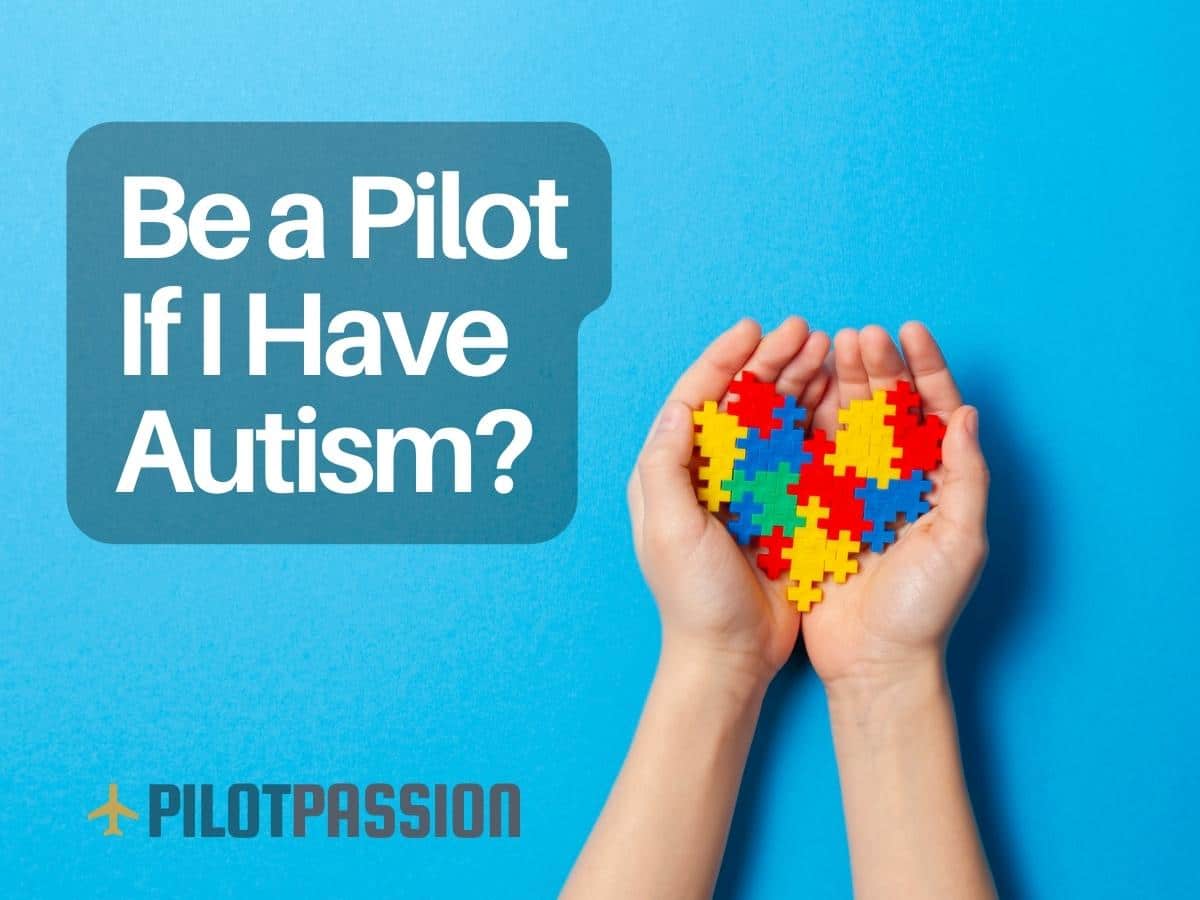Amid the boundless depths of the sky, a compelling query arises: Is it possible for individuals with autism to pursue a career as pilots? The exploration of this matter unfolds a richly detailed story, extending beyond a black-and-white resolution. Strap in as we embark on a journey that intricately weaves through the tangle of industry norms, the extraordinary testimonies of high achievers, and the learning frameworks enabling aspirations.
Yes, people with autism can potentially become pilots. The Federal Aviation Administration (FAA) evaluates each case individually to ensure that safety standards are upheld. Therefore, while there are no categorical restrictions, a comprehensive assessment of the individual’s capabilities is carried out before granting a pilot’s license.
DISCLAIMER: First off, I’m not a doctor, so I need to clarify that nothing you read here should be taken as medical advice. Always consult with an AME in relation to aeromedical topics.
Autism encompasses a wide range of diagnoses, with some individuals having milder symptoms like Asperger syndrome, while others may experience more severe symptoms that could impact their ability to become a pilot.
Factors such as social interaction, communication skills, and ability to adapt to new situations could potentially influence one’s success in the field.

Table of Contents
The Condition and the Demands of Being a Pilot
The Potential Impact of Autism on a Pilot’s Ability to Make Decisions and Fly Safely
Autism, a developmental disorder that affects communication and behavior, can potentially impact a pilot’s ability to make decisions and fly safely. Various factors contribute to the demands of being a pilot, such as maintaining situational awareness, performing under pressure, and effectively communicating with the crew and air traffic controllers.
People with high-functioning autism often excel in areas like attention to detail and focus, which could be advantageous for pilots. However, challenges with social communication and sensory processing may pose difficulties. For example, misinterpreting nonverbal cues or struggling to understand complex instructions in a high-stress environment could impact a pilot’s performance under certain conditions.
In the field of aviation, safety is always the primary concern. Pilots operate complex aircrafts and are responsible for the well-being of their passengers and crew members. To ensure flight safety, potential pilots undergo rigorous medical evaluations, including an assessment of their mental health. The FAA, which governs pilot qualifications in the United States, states that most medical conditions, including autism, can be managed with treatment and/or precautions.
Each autist is unique, and the condition affects people to varying degrees. Some may have minimal to no impact on their ability to fly safely, while others might face greater challenges. As such, the FAA evaluates potential pilots on a case-by-case basis.
Regulatory Stance on Pilots with Autism
FAA’s Stance on Pilots with Autism
The Federal Aviation Administration (FAA) has specific regulations in place for pilots with medical conditions, including autism. The primary concern for the FAA is to ensure the safety of both the pilots and passengers they are responsible for.
As a result, the FAA closely examines the cognitive and communication abilities of individuals with autism before granting them a pilot’s license.
Before becoming a pilot, an individual with autism will need to undergo a thorough examination by an Aviation Medical Examiner (AME). This includes assessing the individual’s cognitive abilities, emotional stability, and communication skills, which are all crucial factors in determining their ability to safely and effectively perform their duties as a pilot.
Consequently, the FAA does not have a strict ban on pilots with autism, but the decision to grant a license is made on a case-by-case basis after careful evaluation by an AME.
Other Global Aviation Regulatory Bodies’ Stance on Pilots with Autism
The stance on pilots with autism might vary among different global aviation regulatory bodies, but most share a similar concern for ensuring the safety of pilots and passengers.
For example, the European Aviation Safety Agency (EASA) has its own set of medical requirements that pilots with autism must meet. Like the FAA, EASA evaluates applicants on a case-by-case basis, considering their cognitive, emotional, and communication abilities.
Regulatory bodies in other countries may also implement their own guidelines and regulations related to pilots with autism.
Individuals with autism who are interested in becoming pilots should research the specific requirements for the country they plan to fly in. In most cases, the key concern for aviation authorities worldwide is to maintain high safety standards for both pilots and passengers, regardless of the specific medical condition in question.

Medical Certification Requirements for Pilots with Autism
Necessary Medical Tests and Evaluations
Pilots with autism need to meet specific medical certification requirements set by the Federal Aviation Administration (FAA). These requirements involve a series of medical tests and evaluations, which may vary depending on the class of medical certificate desired.
To obtain a medical certificate, pilots must be examined by an FAA-designated Aviation Medical Examiner (AME). The AME will assess the pilot’s physical and mental health, ensuring their autism does not interfere with the safe operation of an aircraft.
In some cases, the FAA may require pilots with autism to undergo additional evaluations, such as a psychiatric evaluation or cognitive testing. These tests help assess the applicant’s cognitive and emotional functioning and determine their ability to meet the demands of the aviation environment.
Overcoming Challenges: Stories and Case Studies
Real-Life Examples of Pilots with the Condition
Autism spectrum disorder (ASD) does not necessarily prevent someone from becoming a pilot. There are real-life examples of individuals with autism, such as Hugo Azpurua, who have pursued their dreams in aviation.
How Hugo Managed His Condition and Continued Flying
Pilots with autism, like Hugo, can manage their condition and continue flying by utilizing appropriate accommodations and support. Here are some strategies and accommodations that may be considered:
- Developing routines: Pilots with ASD may find it helpful to establish a set routine, both in their daily lives and in their pre-flight checklists. This can provide a sense of order and predictability, which is often comforting for individuals with ASD.
- Communication strategies: Clear and concise communication is crucial in aviation. For pilots with Asperger’s, focusing on effective communication techniques, such as using visual aids, body language, and verbal cues, can help bridge any gaps.
- Utilizing sensory aids: Individuals with ASD can sometimes be hypersensitive to sensory stimuli. Pilots with the condition might benefit from the use of noise-canceling headphones, fidget tools, or other aids to manage sensory overload during flights.
- Seeking training support: Specialized flight training designed to accommodate the unique needs of pilots with autism can be invaluable. Such training programs can provide individualized guidance on managing ASD symptoms related to focus, anxiety, and emotional regulation in the context of flying.
Risks and Considerations
Potential Risks of Flying with Autism
Autism, a broad spectrum condition, may present certain risks and challenges when pursuing a career as a pilot.
These risks may include sensory sensitivities, difficulties in social interactions, and communication issues. Pilots often face high-pressure situations and stressful environments, which could impact a person with autism differently than an individual without the condition.This is why AMEs will assess each person’s capabilities and limitations on an individual basis.
Similarly, certain mental health conditions may affect a pilot’s ability to safely and successfully perform their duties. Anxiety, depression, personality disorders, and Post-traumatic Stress Disorder (PTSD) might compromise decision-making abilities, stress management, and situational awareness.
Medications That May Affect a Pilot’s Ability to Obtain a Medical Certificate
Various medications and treatments may influence a person’s eligibility for a medical certificate required to become a pilot. The Federal Aviation Administration (FAA) requires pilots to disclose any mental health conditions and medications. Some medications might not be compatible with flying.
Common medications for depression, anxiety, PTSD, ADHD, and psychosis might pose concerns to the FAA. For example:
- SSRIs (Selective Serotonin Reuptake Inhibitors) often prescribed for depression and anxiety
- Benzodiazepines used for anxiety and insomnia
- Stimulants such as Adderall or Ritalin for ADHD
If a pilot is prescribed any of these medications, they may need additional documentation, evaluation, and clearance by an aviation medical examiner (AME) before being deemed fit to fly.

Transparency and Honesty in the Medical Certification Process
Importance of Disclosing Autism During the Certification Process
If you are considering becoming a pilot and have autism, it’s crucial for your safety and the safety of others to be transparent and honest during the medical certification process. Disclosing your condition to the FAA and any relevant medical professionals will allow them to accurately assess your ability to safely operate an aircraft.
When applying for an FAA medical certificate, you will need to provide documentation of your autism diagnosis.
This may include evaluations and reports from your therapist or other medical professionals who have worked with you. By sharing this information, you enable the FAA and the aviation medical examiner (AME) to make an informed decision regarding your eligibility for a medical certificate.
Sharing your autism diagnosis ensures that any necessary accommodations or support mechanisms can be put in place to help you be a successful pilot. This might involve working with your therapist to develop coping strategies for stress, communication, or other challenges related to flying.
Disclosure Requirements
When applying for an FAA medical certificate, pilots with autism must disclose their condition in the FAA Form 8500-8 using the FAA MedXPress system. This online platform simplifies the application process and helps ensure that all relevant information is provided to the AME during the examination. Honest and timely disclosure of the applicant’s medical history, including their autism diagnosis, is critical for determining their eligibility for a medical certificate.
Pilots are also responsible for maintaining their medical certificate by adhering to the regulations outlined in FAR Part 61.53. This code stipulates that pilots must self-ground themselves when they know or have reason to believe their medical condition, in this case, autism, would make them unable to meet the necessary requirements for safe flight operations.
Consequences of Hiding the Condition
Although it might be tempting to avoid disclosing your autism diagnosis during the medical certification process, doing so can have serious consequences. If the FAA discovers that you have intentionally hidden your condition, you could face penalties including a denial of medical certification or even revocation of your pilot certificate.
If you fail to disclose your autism diagnosis and are later involved in an aircraft accident or incident, the FAA may investigate whether your hidden condition contributed to the event. If it is determined that your autism played a role, you could face legal and financial repercussions.
Coping Mechanisms and Support for Pilots with Autism
Tips and Strategies for Managing Autism While Flying
Pilots with autism can develop coping strategies that help them manage their condition while flying. One important aspect to consider is creating a consistent routine to follow before and during flights. This can help reduce anxiety and improve focus. Here are some tips to consider:
- Establish a pre-flight checklist to reduce any possible distractions or stressors
- Use sensory tools like noise-cancelling headphones to minimize distracting sounds
- Utilize visual aids, such as labeled controls or checklists, to help with memory and organization
- Seek therapy to develop personalized coping strategies that cater to individual needs
Along with these individual strategies, having a supportive working environment can be beneficial. This includes open communication with colleagues and employers regarding the pilot’s autism, so they can help accommodate specific needs.
Support Resources Available for Pilots with Autism
There are several resources and organizations available to support pilots with autism. Some of these focus on mental health, therapy, and personal relations, aiming to improve the overall well-being of pilots with autism. Some popular support resources include:
- Support groups tailored to individuals with autism, such as Autism Society or Autism Speaks
- Mental health professionals or therapists with specialization in treating individuals with autism
- Pilot-specific support organizations like Able Flight, which provides scholarships and training for people with disabilities
Children with autism who aspire to be pilots and pilots with ADHD or other conditions may also benefit from the resources provided by these organizations.
Understanding Autism
Brief Explanation of Being Autistic
Autism, or Autism Spectrum Disorder (ASD), is a developmental disorder that affects communication, language skills, and social interaction. The term “spectrum” is used to emphasize the wide range of symptoms and severity.
One well-known type of ASD is Asperger Syndrome, which is generally characterized by milder symptoms and higher-functioning abilities.
Although the exact cause of autism remains unknown, it is generally believed that a combination of genetic and environmental factors contributes to the development of the disorder.
Prevalence of Autism in the General Population
Autism, or Autism Spectrum Disorder (ASD), is a developmental disability that affects behavior, communication, interaction, and learning abilities.
Statistics about Autism
According to the Centers for Disease Control and Prevention (CDC), the identified prevalence of Autism Spectrum Disorder in the United States has been increasing over the past two decades. In 2000, about 1 in 150 children were diagnosed with ASD, while in 2014, this number increased to 1 in 59 children.
- Percentage of boys diagnosed with ASD: 4 times higher than girls
- Prevalence in white children: 1 in 36
- Prevalence in black children: 1 in 38
- Prevalence in Hispanic children: 1 in 43
Facts About Autism
- The symptoms of autism can vary greatly from one person to another, and the severity of the condition can also differ.
- There is no single known cause for autism, but researchers believe that genetic and environmental factors play a role in its development.
- Early intervention and a combination of therapies can improve the quality of life and outcomes for individuals with autism.
These days, there seems to be a better understanding of the prevalence of autism in the general population. This is a good thing because it’s essential for raising awareness and promoting better support services for those diagnosed with the condition. Because of this, more people are able to live fulfilling lives and pursue their dreams, including potentially becoming pilots if they meet other necessary requirements.
Final Thoughts
In the dynamic skies of the aviation world, the question of whether individuals with autism can become pilots has been illuminated. The path isn’t without its challenges, but as we’ve seen, it’s far from impossible.
Each case is unique, treated with careful assessment and understanding. With an aviation industry committed to inclusive growth and a supportive community ready to empower, the dream of flying isn’t exclusive.
Remember, the sky isn’t just for the birds; it’s for everyone who dares to reach it.